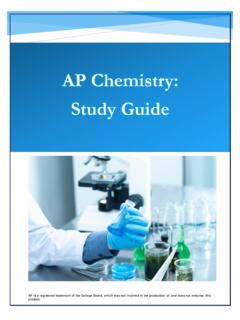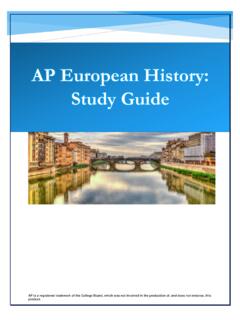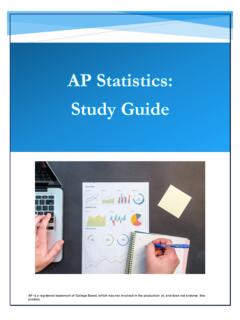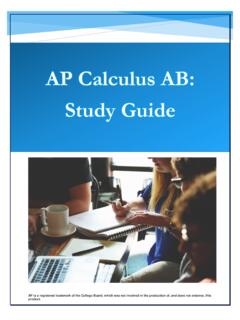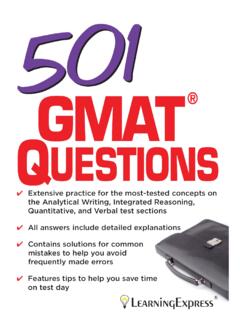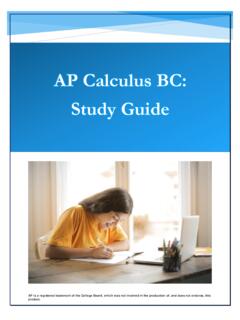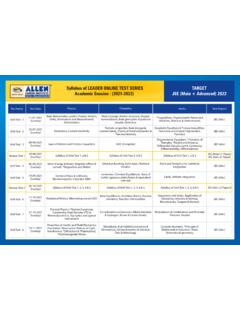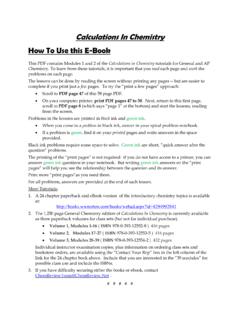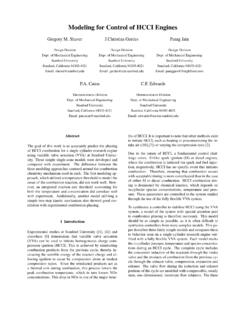Transcription of AP Chemistry Study Guide - EBSCO Connect
1 AP Chemistry : Study Guide AP is a registered trademark of the College Board, which was not involved in the production of, and does not endorse, this product. Key Exam Details The AP Chemistry exam is a 3-hour 15-minute, end-of-course test comprised of 60 multiple-choice questions, for which you will have 1 hour and 30 minutes (this counts for 50% of your score) and 7 free-response questions, for which you will have 1 hour and 45 minutes (this counts for 50% of your score).
2 The exam covers the following course content categories: Atomic Structure and Properties: 7 9% of test questions Molecular and Ionic Compound Structure and Properties: 7 9% of test questions Intermolecular Forces and Properties: 18 22% of test questions Chemical Reactions: 7 9% of test questions Kinetics: 7 9% of test questions thermodynamics : 7 9% of test questions Equilibrium: 7 9% of test questions Acids and Bases: 11 15% of test questions Applications of thermodynamics : 7 9% of test questions This Guide will offer an overview of the main tested subjects, along with sample AP multiple-choice questions that look like the questions you will see on test day. Atomic Structure and Properties Around 7 9% of questions on your AP Chemistry exam will cover Atomic Structure and Properties.
3 The physical world is made of matter, which is any substance that has mass and occupies space. Atoms are the fundamental unit of matter, and the smallest unit that retains all the properties of an element. Molecules are a group of atoms that are bonded together to form a chemical compound. This section will go into detail about the structure and properties of atoms. Moles and Molar Mass The international standard unit of measure for the number of molecules in a substance is a mole. A mole is equal to Avogadro s number, or 1023, which is standardized to the number of atoms that are present in 12 grams of Carbon-12. A mole of a substance is always the same number of particles, regardless of what the substance is ( , hydrogen atoms, water particles, 1 electrons).
4 You can think of this in the same way that a dozen always means 12, regardless of whether it refers to eggs or days. The molar mass of substance, also called the molecular weight or molecular mass, is the total mass of one mole of that substance, expressed as grams/mole. Molar mass is used to convert the mass of a substance to the number of molecules present using the following conversion: weight in grams # of moles = molar mass # of moles of substance = (# of moles of substance) (Avogadro s number) This relationship is used to determine the number of molecules present given the mass of a pure chemical using the atomic mass on the periodic table. To determine the number of molecules present in a compound, calculate the number of moles present using mass in grams and the molar mass. This number is then multiplied by Avogadro s number to determine the number of molecules.
5 Mass Spectroscopy Scientists can measure the abundance of different atoms in a sample using mass spectroscopy. A mass spectrometer separates molecules in a sample based on their charge and weight. To do this, the sample is first charged by bombarding it with electrons. Magnetic fields then separate ions by charge, and the relative abundance of ions in a sample are read by a detector. Ions of different masses need different strengths of magnetic fields to reach the detector. Results are plotted showing the mass-to-charge ratio on the x-axis (m/z) and the relative abundance of each atom type on the y-axis. You may be asked on the AP exam to determine the relative abundance of different isotopes of an element based on mass spec results. Elemental Composition of Pure Substances Pure substances are made of a single type of substance that has consistent characteristics and cannot be broken down further through physical processes.
6 A pure substance that is made of a single type of atom is called an element. A pure substance that is made of only one type of molecule is called a compound. According to the law of definite proportions, a pure chemical compound broken down into elements always contains elements of a fixed ratio, independent of where and how it was created. For example, pure water will always contain the same ratio of hydrogen and oxygen, regardless of where it is found. 2 Composition of Mixtures A mixture is made of more than one type of element or compound.
7 The components in a mixture can have different proportions. For example, you can make a 20% saline solution out of 20% sodium chloride and 80% water, or you can make a 5% saline solution out of 5% sodium chloride and 95% water; yet both are still saline. When you make a mixture, no chemical reactions take place, so you could still theoretically recover the individual components back to their pure forms. In the case of saline, you could evaporate off the water and recover both the sodium chloride and the water. Mixtures can be homogenous, meaning all parts of the mixture are identical to other parts due to even distribution of compounds, or mixtures can be heterogenous, as in there is a non-uniform distribution of compounds. Atomic Structure and Electron Configuration Atoms are made of smaller subatomic particles including positively charged protons, negatively charged electrons, and uncharged neutrons.
8 Protons and neutrons together occupy the tightly packed nucleus of an atom, while electrons orbit outside of the nucleus in electron shells. Together, subatomic particles determine the identity, mass, and charge of an atom. Protons and neutrons have the same approximate mass ( 10-27 kg), while electrons contribute a negligible amount of mass (roughly 1/1,800 the mass of the protons and neutrons). Thus, protons and neutrons are included in estimating mass of an element and electrons are not. The mass number is a whole number equal to the number of protons and neutrons of an element. The mass of a single proton or neutron is 1 atomic mass unit (amu). The number of protons in the nucleus is called the atomic number. The atomic symbol of an element is represented as: Where X is the element symbol, A is the mass number, and Z is the atomic number.
9 The atomic number defines which element an atom is. For example, carbon has 6 protons; the addition of a proton to a carbon atom would make it change to nitrogen. On the other hand, the number of neutrons in an individual atom of an element can vary, changing the mass number of an atom. Atoms with the same number of protons but different number of neutrons are called isotopes of an element. To determine the number of neutrons in an atom, subtract the atomic number from the mass number. Atomic mass is the average mass number of all the atoms of that element. Atomic mass on the periodic table can give you an idea of the proportion of isotopes present. For example, lithium (L) has an atomic number of 3 and an atomic mass of , indicating that many lithium atoms on Earth have more than the 3 neutrons in their nucleus.
10 3 Atomic charge is determined by the relative number of electrons and protons of an atom. While the number of protons of an atom is stable, the number of electrons varies. Atoms with a non-zero charge are called ions. An atom with an equal number of protons and electrons has a neutral charge. Since electrons are negatively charged, the addition of an electron gives a negative charge to an atom, creating an anion.
